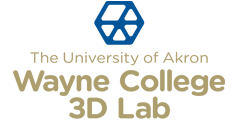Hello everyone,
Not a day passes when someone isn’t using the 3D Lab to work on projects, even in the middle of summer when most students are on break! It is a good time to clean-up the lab, fix minor problems with the machines, and improve procedures for using them. It is always wonderful to see people from different backgrounds come together to provide advice, teach each other how to use the equipment, and just have fun making things together.
Summer also means summer camp, and this summer brings kids from the Orrville Area Boys and Girls Club to the 3D Lab to build “chuck gliders”. These non-motorized model airplanes are laser cut from foam board, decorated, then flown outside by tossing in the air or launched via a long rubber band.
The camp started a few weeks ago. The first two sessions explained how airplanes work and fly, taught by our Flight Club expert Chris Ryan and community members. The kids had a blast flying powered planes with “tandem controllers”. This involves two controllers connected via a cable, allowing kids to practice flying but also allows the instructor to instantly take control of the plane if a crash is emminent. 🙂
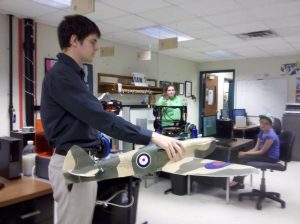
Chris talks about his latest plane
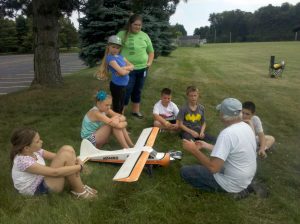
Explaining flight dynamics
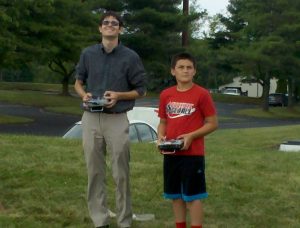
Flying planes with tandem controllers
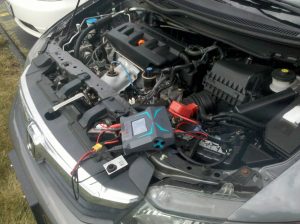
Quick way to recharge plane batteries!
The last week of the June, the Schantz Organ Company hosted its second session of “Maker Monday”. Here, community members gathered in a large workshop to discuss projects that they are working on. These roundtable discussions are fascinating, with folks building custom fireplaces, musical instruments, 3D printed military models, Arduino and Raspberry Pi projects, medical devices, sewing racks, and so much more. The group offered advice and encouragement to everyone; it’s a wonderful way to network and make new friends!
The Maker Monday group also discussed collaboration on a future project: building a Arduino based creative light display for the Cornerstone School playground rennovation project in Wooster. Ultimately, students will be able to program their own light animations that can be seen outside by the public. It will be an exciting project! If you wish to be involved, please send an email to tjh1@uakron.edu
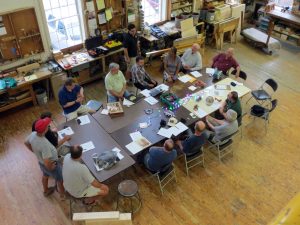
The Maker Monday group
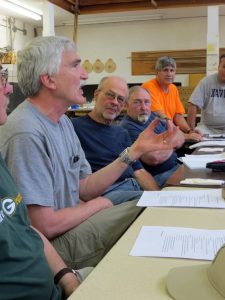
Greg reveals the new “C.H.I.P.” micro computer for electronics projects
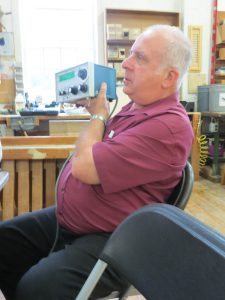
Mike explains an accordian tuning device that he invented
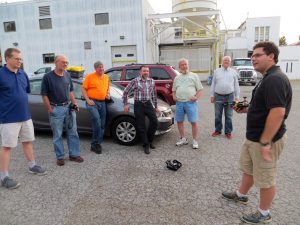
Sami’s drone flight demonstration
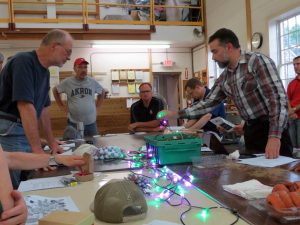
Cornerstone School lighting project
Above photos courtesy Paul Locher / The Daily Record
Back at the 3D Lab, employees of the Schantz Organ Company visited with a project in-hand. As organs age, sometimes parts break and the originating companies nor longer stock parts for them. In this particular case, an organ uses a metal bracket to hold pistons. These pistons are basically push switches that activate certain features on the organ. The metal brackets would bend/break over time, but replacement brackets are no longer available from the manufacturer.
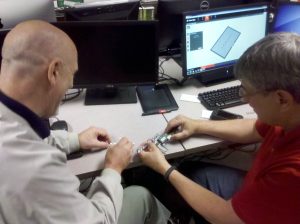
Victor Schantz and a colleague wondered if 3D printing would be a solution. They took measurements of the existing bracket, then 3D printed a copy using ABS plastic. The result was flimsy, going from metal to plastic. But the solution was simple. Why not redesign the bracket from scratch? The original metal bracket was folded for strength, but with 3D printing, the entire bracket can strengthened in ways not possible through folding alone. In the end, they created a bracket that is better than the original! Now they can print extra brackets on demand. It was an excellent solution.
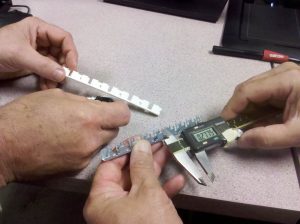
Community member Norm recently built pine birdhouses to be donated to the Ohio Mennonite Relief Sale & Auction. For an extra touch of class, he wondered if the organization’s name & logo could be laser engraved onto the birdfeeders’ facing wall.
The nice thing about laser engraving is that all shapes and sizes of objects can be engraved; it just a matter of keeping a flat surface and a proper distance from the laser’s head. But the problem with engraving bare wood is that the beam can scorch the surrounding area, looking like bleeding ink around the letters.
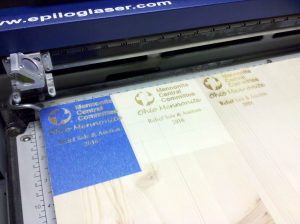
While visiting Lorain Community College’s FabLab last year, we learned a trick. Folks there covered wood with masking tape before engraving. The laser beam cuts through the tape, but only the tape is scorched and not the underlying wood. After removing the tape, the engraving underneath was perfect! Norm was quite pleased with the result.
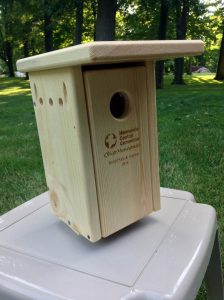
Stay tuned next week as we report more about the summer camp and a new “game programming camp” planned for August!

In the medical world, see how surgeons implant world’s first 3D printed titanium sternum:
https://3dprint.com/79908/3d-printed-sternum-implant
See how a 3D printed micro-camera is small enough to be injected into the human body with a syringe:
Until next week,
Tom
